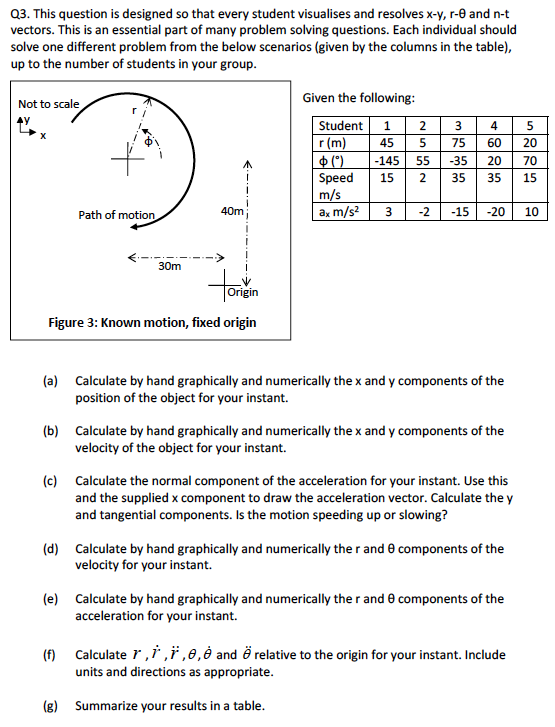question is designed every stu vectors. This is an essential part of many problem solving questions. Each individual should solve one different problem from the below scenarios (given by the columns in the table), up to the number of students in your group. Not to scale Given the following: 4 5 20 Student 1 2 3 r (m) $ (*) Speed m/s a, m/s² 45 5 75 60 -145 55 -35 20 70 15 2 35 35 15 Path of motion 40m 3 -2 -15 -20 10 30m Origin Figure 3: Known motion, fixed origin (a) Calculate by hand graphically and numerically the x and y components of the position of the object for your instant. (b) Calculate by hand graphically and numerically the x and y components of the velocity of the object for your instant. (c) Calculate the normal component of the acceleration for your instant. Use this and the supplied x component to draw the acceleration vector. Calculate the y and tangential components. Is the motion speeding up or slowing? (d) Calculate by hand graphically and numerically the r and 0 components of the velocity for your instant. (e) Calculate by hand graphically and numerically the r and e components of the acceleration for your instant. (f) Calculate r,i,ï,0,ð and ë relative to the origin for your instant. Include units and directions as appropriate. Summarize your results in a table.
question is designed every stu vectors. This is an essential part of many problem solving questions. Each individual should solve one different problem from the below scenarios (given by the columns in the table), up to the number of students in your group. Not to scale Given the following: 4 5 20 Student 1 2 3 r (m) $ (*) Speed m/s a, m/s² 45 5 75 60 -145 55 -35 20 70 15 2 35 35 15 Path of motion 40m 3 -2 -15 -20 10 30m Origin Figure 3: Known motion, fixed origin (a) Calculate by hand graphically and numerically the x and y components of the position of the object for your instant. (b) Calculate by hand graphically and numerically the x and y components of the velocity of the object for your instant. (c) Calculate the normal component of the acceleration for your instant. Use this and the supplied x component to draw the acceleration vector. Calculate the y and tangential components. Is the motion speeding up or slowing? (d) Calculate by hand graphically and numerically the r and 0 components of the velocity for your instant. (e) Calculate by hand graphically and numerically the r and e components of the acceleration for your instant. (f) Calculate r,i,ï,0,ð and ë relative to the origin for your instant. Include units and directions as appropriate. Summarize your results in a table.
Principles of Heat Transfer (Activate Learning with these NEW titles from Engineering!)
8th Edition
ISBN:9781305387102
Author:Kreith, Frank; Manglik, Raj M.
Publisher:Kreith, Frank; Manglik, Raj M.
Chapter5: Analysis Of Convection Heat Transfer
Section: Chapter Questions
Problem 5.18P: The drag on an airplane wing in flight is known to be a function of the density of air (), the...
Related questions
Question
please answer a to g. thanks

Transcribed Image Text:Q3. This question is designed so that every student visualises and resolves x-y, r-0 and n-t
vectors. This is an essential part of many problem solving questions. Each individual should
solve one different problem from the below scenarios (given by the columns in the table),
up to the number of students in your group.
Not to scale
Given the following:
Student
1
2
3
|r (m)
$ (*)
45
75
60
20
-145
55
-35
70
Speed
15
35
35
15
m/s
ax m/s?
Path of motion
40m
-2
-15
-20
10
30m
Origin
Figure 3: Known motion, fixed origin
(a) Calculate by hand graphically and numerically the x and y components of the
position of the object for your instant.
(b) Calculate by hand graphically and numerically the x and y components of the
velocity of the object for your instant.
(c) Calculate the normal component of the acceleration for your instant. Use this
and the supplied x component to draw the acceleration vector. Calculate the y
and tangential components. Is the motion speeding up or slowing?
(d) Calculate by hand graphically and numerically the r and 0 components of the
velocity for your instant.
(e) Calculate by hand graphically and numerically the r and 0 components of the
acceleration for your instant.
(f) Calculate *, ,ï,e,è and ë relative to the origin for your instant. Include
units and directions as appropriate.
(g) Summarize your results in a table.
Expert Solution
This question has been solved!
Explore an expertly crafted, step-by-step solution for a thorough understanding of key concepts.
Step by step
Solved in 3 steps

Knowledge Booster
Learn more about
Need a deep-dive on the concept behind this application? Look no further. Learn more about this topic, mechanical-engineering and related others by exploring similar questions and additional content below.Recommended textbooks for you

Principles of Heat Transfer (Activate Learning wi…
Mechanical Engineering
ISBN:
9781305387102
Author:
Kreith, Frank; Manglik, Raj M.
Publisher:
Cengage Learning

Principles of Heat Transfer (Activate Learning wi…
Mechanical Engineering
ISBN:
9781305387102
Author:
Kreith, Frank; Manglik, Raj M.
Publisher:
Cengage Learning